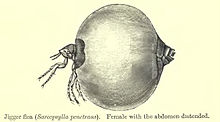- Chigoe flea
-
Chigoe flea 
Scientific classification Kingdom: Animalia Phylum: Arthropoda Class: Insecta Order: Siphonaptera Family: Hectopsyllidae Genus: Tunga Species: T. penetrans Binomial name Tunga penetrans
(Linnaeus, 1758)The chigoe flea or jigger (Tunga penetrans) is a parasitic arthropod found in most tropical and sub-tropical climates, not to be confused with the larval form of Trombiculidae (called chiggers) found in more temperate climates. In Brazil, the parasite is referred to as bicho-de-pé (foot bug). At 1 mm long, the chigoe flea is the smallest known flea. Breeding female chigoes burrow into exposed skin on the feet of mammals and remain there for two weeks while developing eggs, sometimes causing intense irritation. After this point, the skin lesion looks like a 5 to 10 mm blister with a central black dot, which are the flea's exposed hind legs, respiratory spiracles and reproductive organs.
If the flea is left within the skin, infection and/or other dangerous complications can occur, although they are relatively rare.
The parasitic flea lives in soil and sand, and feeds intermittently on warm-blooded hosts such as humans, cattle, sheep, dogs, mice, and other animals. In order to reproduce, the female flea burrows head-first into the hosts' skin, often leaving the caudal tip of its abdomen visible through an orifice in a skin lesion. This orifice allows the chigoe flea to breathe and defecate while feeding on blood vessels in the cutaneous and subcutaneous dermal layer. In the next two weeks, its abdomen swells with up to several dozen eggs which it releases through the caudal orifice to fall to the ground when ready to hatch. The flea then dies and is sloughed off with the host's skin. Within the next three to four days, the eggs hatch and mature into adult fleas within three to four weeks.
Infections are almost always on the foot of the host. During the first day or two of infection the host may feel an itching or irritation which then passes as the area around the flea calluses and becomes insensitive. As the flea's abdomen swells with eggs later in the cycle, the pressure from the swelling may press neighbouring nerves or blood vessels. Depending on the exact site, this can cause sensations ranging from mild irritation to serious discomfort.
It has been written that the explanation for the preponderance of tungiasis lesions on the toes is because chigoe flea is a poor jumper, attaining only a high of 20 cm [1]. But this idea is not correct for many reasons. First of all, while chigoe flea can jump up only 20 cm, its infamous and bigger cousin Flea which is the vector of bubonic plague and well known for its jumping ability, can jump up only 18 cm; the chigoe flea should be considered a champion jumper, not a poor one. And the jumping ability cannot explain why hands are the second most affected body part. The occurrence of tungiasis lesions on the toes, between them, on the soles can easily explained by the fact that most of the victims are poor and walk barefoot (or wear cheap floppies as seen in some photos of the condition). Because the front part of the feet, which are the toes hit the ground first, the fleas have more opportunity to latch on there. They also get trapped between the toes, or under the soles when the victims stand still. More lesions on the hands are seen in children because they play in the sand or dusty ground. Other common ectopic sites of infestation are the elbows, buttocks and the genital area (gluteal area in scientific publications) and this can be explained by the habit of sitting on bare ground while leaning back on the elbows.
A study published in 2006 [2] has concluded that "Contrary to common belief, a protective effect of frequent use of closed footwear could not be demonstrated".
Contents
Synonyms
- Sarcopsylla penetrans
- Pulex penetrans
The chigoe is sometimes called a "chigger," a term also used for the harvest mite in North America.
In Lingala speaking areas it is commonly known as "liyanzi" (singular) or "mayanzi" (plural).
In Spanish, the chigoe is commonly known as "pique" due to the itching and burning sensation that it produces; in Colombia it is known as "nigua". In Guarani Guarani, the national language of Paraguay, it is known as tũ.
In Kinyarwanda and Kirundi, they are known as "ivunja/imvunja" (Singular) or "Amavunja" (Plural).
See also
References
External links
- http://www.afronets.org/archive/200110/msg00058.php
- Periungual Tungiasis Muehlstaedt M (2008) Images in clinical medicine. Periungual tungiasis. N Engl J Med 359(24):e30.
- http://www.feedthechildren.org.uk/pages/JiggersCampaignPage.shtml Stamp Out Jiggers Campaign by Feed The Children UK, Supported by The Hoosiers.
Categories:- Fleas
- Fauna of the United States
- Animals described in 1758
Wikimedia Foundation. 2010.
